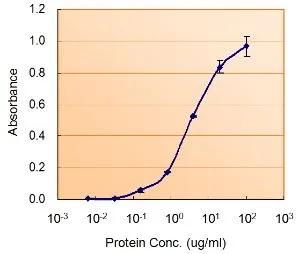Nanog antibody [N3C3]
GTX100863
ApplicationsImmunoFluorescence, ImmunoPrecipitation, Western Blot, ELISA, ImmunoCytoChemistry, ImmunoHistoChemistry, ImmunoHistoChemistry Frozen, ImmunoHistoChemistry Paraffin
Product group Antibodies
TargetNANOG
Overview
- SupplierGeneTex
- Product NameNanog antibody [N3C3]
- Delivery Days Customer9
- Application Supplier NoteWB: 1:500-1:3000. ICC/IF: 1:100-1:1000. IP: 1:100-1:500. ELISA: 1:1000-1:10000. *Optimal dilutions/concentrations should be determined by the researcher.Not tested in other applications.
- ApplicationsImmunoFluorescence, ImmunoPrecipitation, Western Blot, ELISA, ImmunoCytoChemistry, ImmunoHistoChemistry, ImmunoHistoChemistry Frozen, ImmunoHistoChemistry Paraffin
- CertificationResearch Use Only
- ClonalityPolyclonal
- Concentration0.5 mg/ml
- ConjugateUnconjugated
- Gene ID79923
- Target nameNANOG
- Target descriptionNanog homeobox
- Target synonymshomeobox protein NANOG, homeobox transcription factor Nanog, homeobox transcription factor Nanog-delta 48
- HostRabbit
- IsotypeIgG
- Protein IDQ9H9S0
- Protein NameHomeobox protein NANOG
- Scientific DescriptionTranscription regulator involved in inner cell mass and embryonic stem (ES) cells proliferation and self-renewal. Imposes pluripotency on ES cells and prevents their differentiation towards extraembryonic endoderm and trophectoderm lineages. Blocks bone morphogenetic protein-induced mesoderm differentiation of ES cells by physically interacting with SMAD1 and interfering with the recruitment of coactivators to the active SMAD transcriptional complexes (By similarity). Acts as a transcriptional activator or repressor (By similarity). Binds optimally to the DNA consensus sequence 5-TAAT[GT][GT]-3 or 5-[CG][GA][CG]C[GC]ATTAN[GC]-3 (By similarity). When overexpressed, promotes cells to enter into S phase and proliferation.
- Storage Instruction-20°C or -80°C,2°C to 8°C
- UNSPSC12352203
References
- Tsai YF, Chan LP, Chen YK, et al. RAD51 is a poor prognostic marker and a potential therapeutic target for oral squamous cell carcinoma. Cancer Cell Int. 2023,23(1):231. doi: 10.1186/s12935-023-03071-wRead this paper
- Masola V, Franchi M, Zaza G, et al. Heparanase regulates EMT and cancer stem cell properties in prostate tumors. Front Oncol. 2022,12:918419. doi: 10.3389/fonc.2022.918419Read this paper
- Huang H, Liu J, Li M, et al. Cis-regulatory chromatin loops analysis identifies GRHL3 as a master regulator of surface epithelium commitment. Sci Adv. 2022,8(28):eabo5668. doi: 10.1126/sciadv.abo5668Read this paper
- Kim SH, Fan PW, Hsieh CH, et al. The aqueous extract of brucea javanica reduces tumorigenicity of human lung cancer tumorspheres. Cancer Drug Resist. 2021,4(4):866-880. doi: 10.20517/cdr.2021.58Read this paper
- Papes F, Camargo AP, de Souza JS, et al. Transcription Factor 4 loss-of-function is associated with deficits in progenitor proliferation and cortical neuron content. Nat Commun. 2022,13(1):2387. doi: 10.1038/s41467-022-29942-wRead this paper
- Zhang W, Li Y, Wang L, et al. Generation of a DKK2 homozygous knockout human embryonic stem cell line using the CRISPR/Cas9 system. Stem Cell Res. 2021,57:102611. doi: 10.1016/j.scr.2021.102611Read this paper
- Mohankumar K, Shrestha R, Safe S. Nuclear receptor 4A1 (NR4A1) antagonists target paraspeckle component 1 (PSPC1) in cancer cells. Mol Carcinog. 2022,61(1):73-84. doi: 10.1002/mc.23362Read this paper
- Mashiko T, Kanayama K, Saito N, et al. Selective Proliferation of Highly Functional Adipose-Derived Stem Cells in Microgravity Culture with Stirred Microspheres. Cells. 2021,10(3). doi: 10.3390/cells10030560Read this paper
- Wang SM, Lin WC, Lin HY, et al. CCAAT/Enhancer-binding protein delta mediates glioma stem-like cell enrichment and ATP-binding cassette transporter ABCA1 activation for temozolomide resistance in glioblastoma. Cell Death Discov. 2021,7(1):8. doi: 10.1038/s41420-020-00399-4Read this paper
- Carelli S, Giallongo T, Rey F, et al. Neural precursors cells expanded in a 3D micro-engineered niche present enhanced therapeutic efficacy in vivo. Nanotheranostics. 2021,5(1):8-26. doi: 10.7150/ntno.50633Read this paper







![ICC/IF analysis of NTERA-2 cells (left) and HeLa cells (right) using GTX83107 Nanog antibody [1E6C4]. Green : Nanog Red: Actin filaments](https://www.genetex.com/upload/website/prouct_img/normal/GTX83107/GTX83107_20170912_ICCIF_w_23061322_482.webp)
